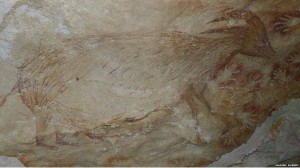BBC News – Cave paintings change ideas about the origin of art
 Scientists have identified some of the earliest cave paintings produced by humans.
Scientists have identified some of the earliest cave paintings produced by humans.
The artworks are in a rural area on the Indonesian Island of Sulawesi.
Until now, paintings this old had been confirmed in caves only in Western Europe.
Researchers tell the journal Nature that the Indonesian discovery transforms ideas about how humans first developed the ability to produce art.
Australian and Indonesian scientists have dated layers of stalactite-like growths that have formed over coloured outlines of human hands.
Early artists made them by carefully blowing paint around hands that were pressed tightly against the cave walls and ceilings. The oldest is at least 40,000 years old.
Wild Pig This painting, from Bone, is of a variety a wild endemic dwarfed bovid found only in Sulawesi, which the inhabitants probably hunted
There are also human figures, and pictures of wild hoofed animals that are found only on the island. Dr Maxime Aubert, of Griffith University in Queensland, Australia, who dated the paintings found in Maros in Southern Sulawesi, explained that one of them (shown immediately below) was probably the earliest of its type.
Oldest Art At the top of the worn painting is a faint outline of a human hand. Below it is possibly the earliest depiction of an animal
“The minimum age for (the outline of the hand) is 39,900 years old, which makes it the oldest hand stencil in the world,” said Dr Aubert.
via BBC News – Cave paintings change ideas about the origin of art.
Photo credit: Maxime Aubert